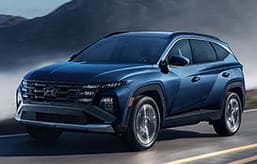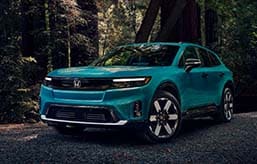- An outstanding ride highlights the all-new 2022 Hyundai Ioniq 5 in our first test.
- The Tesla Model Y offers more cargo space and greater ease of DC fast charging.
- Due to its build quality and attractive price, the Ioniq 5 is our choice.
2022 Hyundai Ioniq 5 vs. 2021 Tesla Model Y: Which EV Is Best?
We test the intriguing Ioniq 5 and declare a winner
Any way you slice it, the debut of the 2022 Hyundai Ioniq 5 seems to be a case of right place, right time. After all, the Ioniq 5 is a fully electric vehicle as EV demand is on the rise, and it's a small crossover with the space and utility shoppers need. Naturally, we wanted to match one against the current electric SUV king — the Tesla Model Y.
Am I Ready for an EV?
- EV ownership works best if you can charge at home (240V outlet)
- Adding a home charging system is estimated to cost $1,616 in
- Edmunds is partnering with Treehouse, an independent provider of home EV installation services. Learn more about the installation services partnership
We put the Ioniq 5 through our industry-leading evaluation, including our real-world EV range test, then drove it back to back with the Model Y to see how the two rivals compare. Below you'll see what we learned in terms of performance, efficiency, utility, tech and more. If the future is electric, these two vehicles appear poised to lead the way. Keep reading to see which EV came out on top.
Ioniq 5 vs. Model Y: Types and trim levels
The Ioniq 5 comes in your choice of three trim levels: SE, SEL and Limited. Each one adds more comfort and technology features as standard equipment as you go up. More importantly, however, the Ioniq 5 offers three powertrain types. Here they are:
- SE Standard Range (delayed availability): 58-kWh battery pack; single rear motor; 168 horsepower
- SE/SEL/Limited: 77-kWh battery pack; single rear motor; 225 hp
- SE/SEL/Limited: 77-kWh battery pack; dual-motor AWD; 320 hp
Of these models, it's the dual-motor AWD model that competes most closely with the Model Y. At that level, the Hyundai Ioniq 5 price starts at $48,375 for the SE model including the destination fee. In its highest Limited model, the Ioniq 5 price comes to $55,725. We used a dual-motor Ioniq 5 Limited for the purposes of our comparison.
Tesla currently offers two versions of the Model Y:
- Model Y Long Range: 75-kWh battery pack; dual-motor AWD; 350 hp (Edmunds estimate)
- Model Y Performance: 75-kWh battery pack; dual-motor AWD; 450 hp (Edmunds estimate)
At the time of our review's publication, Tesla offered the Model Y Long Range for $62,190 including the destination fee and the Model Y Performance for $65,190 to start. Given its price and performance, we consider the Model Y Long Range the closer competitor for the dual-motor Ioniq 5 Limited. We'll be primarily comparing these two EVs in the article, but note that in the related comparison video we featured our long-term 2020 Model Y Performance because a Model Y Long Range wasn't available at the time of the video's production.
Ioniq 5 vs. Model Y: Power and performance
Let's skip right to the good stuff. Namely, how does the Ioniq 5 stack up against the Model Y on the road?
Believe it or not, quite well. While the Ioniq 5 is more focused on comfort than speed, we were nonetheless impressed by how it performed in our instrumented testing.
At our test track the dual-motor AWD Ioniq 5 hit 60 mph in 4.7 seconds and finished the quarter mile in 13.3 seconds at 100 mph. This is plenty fast, and it provides thrilling bursts of speed when called upon. It even sends more power to the rear wheels than expected, providing extra fun for sporting drivers — a pleasant surprise to our test team.
The Ioniq 5 also performed well in braking and handling tests. From 60 mph it came to a full stop in 118 feet. This is shorter than average for an EV in this price range, and the Ioniq 5 remained stable and confident in this emergency braking situation. Likewise, it measured 0.91 g on our handling skidpad, which is indicative of good grip on the road.
When we recently tested a 2021 Model Y Long Range, it too posted impressive numbers. The Tesla was only a tick behind the Hyundai to 60 mph, at 4.8 seconds. But it took the win in the quarter mile at 12.9 seconds at a much faster 110 mph. The Model Y Long Range also had a better braking figure, coming to a full stop from 60 mph in 112 feet.
On paper, these two EVs are closely matched. But in practice, the Model Y is a little less composed under hard braking and sudden maneuvers. We attribute this to the stiff suspension that gives the Model Y nimble handling yet also makes it more easily upset over imperfect surfaces.
Ioniq 5 vs. Model Y: Range
Finally, the moment of truth. Here are the EPA estimates for how far you can travel on a full charge in the Ioniq 5 and close rivals:
- 2022 Ioniq 5 AWD: 256 mi
- 2021 Volkswagen ID.4 Pro: 260 mi
- 2021 Ford Mustang Mach-E AWD Extended Range: 270 mi
While we deem 256 miles appropriate for normal driving, you can see that it's less than some rivals offer. And even the more affordable Ioniq 5 rear-wheel-drive version offers 303 miles.
But what about on our standardized Edmunds EV range test? Well, the Ioniq 5 outperformed its EPA estimates. But so did many competitors. Here's how it panned out:
- Ioniq 5 AWD: 270 mi (+14 over rating)
- Volkswagen ID.4 Pro: 288 mi (+28 over rating)
- Ford Mustang Mach-E AWD Extended Range: 304 mi (+34 over rating)
Like most EVs on the market, it's reassuring to know the Ioniq 5 packs extra range into its estimated total.
When it comes to Teslas, range is a complicated topic. We've run every Tesla currently on sale — the Model S, Model X, Model 3 and multiple versions of the Model Y — through our standardized EV range test, and none has ever reached its EPA estimate.
Here's the Model Y's EPA estimate at the time of our testing:
- 2021 Model Y Long Range: 326 mi
And here's what we observed in our testing:
- Model Y Long Range: 317 mi (-9 under rating)
As you can see, the Model Y fell short of its EPA-estimated rating. Now, 317 miles is an impressive figure and it outpaces the Ioniq 5 AWD. Just know that the Model Y doesn't overperform on its EPA estimates, unlike most competitors.
You can see more of our EV range tests on our EV range leaderboard.
Ioniq 5 vs. Model Y: Interior space and comfort
What about actually using these cars on a day-to-day basis? Here's what we found.
We'll start with how you get in. The Ioniq 5 has clever door handles, which pop out automatically upon unlocking the car. On some models they activate when the key is within 3 feet of the door. It's slightly awkward to grasp and pull on the thin protruding handle, but we like them better than the Model Y's handles. Once inside, there is good headroom and legroom for front passengers. The cabin is airy and the seats have a wide range of adjustments — the driver's seat can fold nearly flat while you wait on charging.
Drawbacks include a steering wheel that doesn't telescope enough to find an ideal driving position, as well as limited rear legroom compared with the Model Y. (The rear seats recline in the Ioniq 5, but we'd trade this feature for extra space.) Finally, the Ioniq 5 has large rear roof pillars that create troubling blind spots from some angles. But forward visibility is excellent, and a range of exterior cameras are helpful in tight spaces.
Getting into the Model Y takes some getting used to because of its unusual door handles. You manually press them in, which enables you to pull on the part that pops out to open the door. As stated earlier, we prefer the power-extending handles on the Ioniq 5. Otherwise the Model Y is simple to use. It's easy to get inside due to wide-opening doors and seats positioned at thigh-height for most adults. Once inside there is loads of head space, both front and rear, due to the panoramic glass roof. There is also plentiful legroom in the first two rows.
One major difference between these two models is the Model Y offers a third row of seats. The third row is suitable for small children only — adults will find the roofline leaves no space, troublingly, for their heads. The Model Y also has an airy cabin and limited rear visibility, but the windshield pillars are significantly larger than those in the Ioniq 5, and they hamper your outward view. Of course, Tesla includes a range of different camera views to help you out.
Ioniq 5 vs. Model Y: Tech
Let's see how these rivals approach technology, shall we?
A 12.3-inch central touchscreen comes standard across all Ioniq 5 trim levels. It includes both Apple CarPlay and Android Auto smartphone integration. Neither is available with wireless connectivity, which is an increasingly common feature in the latest cars, so you'll still need to use a USB cord to plug in your phone. The screen is otherwise excellent, with clear maps and graphics, plus quick response when you touch, swipe or even pinch it.
The Ioniq 5 also has a second info screen in front of the driver, displaying information such as speed, energy use and route directions. Of course, the Model Y has no such driver display. In the Ioniq 5, this means there is essential information directly in your field of vision while driving — a big plus in our minds. We also like the augmented reality directions that appear in the head-up display, which is an innovative touch in a vehicle that should feel futuristic.
There's no getting around it — apart from driving components, the 15-inch central touchscreen is the single most important piece of hardware in the Model Y. It controls everything from the door locks to the air conditioning, not to mention normal screen functions like maps, music and cameras. There's an impressive breadth of functionality to the Model Y screen, but it comes at a cost. That becomes apparent when you need to take three, four or more steps to reach the command you want, closing your current menu and scrolling through others just to perform something as simple as shifting the air vents in a safe manner.
Our biggest problem with this? It takes your attention away from the road. These functions needn't be so complicated, and while Tesla's total commitment to the screen once felt like the future, it now seems needlessly impractical. Another downside is that the screen won't mirror your smartphone's apps; there's no Apple CarPlay or Android Auto.
One big advantage for the Model Y is Tesla's habit of issuing expansive upgrades through wireless over-the-air (OTA) updates without the need to visit a dealer or service station. The Ioniq 5 offers OTA updates, but only for maps and multimedia. With the Model Y, it can extend to things as critical as horsepower and total range. Nifty stuff.
Ioniq 5 vs. Model Y: Charging
Charging the Ioniq 5 works like charging any other electric vehicle. It has a charge port on the rear passenger quarter panel, and you can use a household outlet (albeit at super slow recharging speed), a Level 2 charger or a Level 3 DC fast-charging station to juice it up.
Notably, the Ioniq 5 is compatible with super-speedy Level 3 DC fast charging — up to 350 kW. Previously, only high-end EVs such as the Porsche Taycan had such compatibility. Hyundai says you can recharge from 10% to 80% in just 18 minutes on a 350-kW fast charger, or fill up with 68 miles of range in just five minutes.
Just know that these powerful 350-kW chargers are still pretty rare — most DC fast-charging stations you'll come across are capable of providing 50 kW to 125 kW. Even so, you can kind of consider the Ioniq 5 to be future-proofed to take advantage of more powerful fast charging as it rolls out in the coming years.
The Ioniq 5 also has another major trick up its sleeve. Hyundai calls it vehicle-to-load, or V2L. This is essentially a function where you can power electronics or appliances, such as a smartphone, laptop or even a coffee maker or hair dryer, using either the Ioniq 5's battery pack. You can plug in using the car's exterior charging port (with an adapter) or a household-style power port inside the vehicle. This is a neat feature with no Tesla equivalent.
Still, the Model Y has its own charging advantages. There is one charge port located on the driver's side taillight assembly, which offers easy access for Tesla's proprietary charging cord. As with the Ioniq 5, you can charge at home with a household plug or an L2 charger.
Of course, the big draw for many people is the ability to use Tesla's Supercharger extensive and reliable nationwide network of proprietary fast-charging stations. We are fans of this system and think Tesla deserves true pioneer status for spearheading the charging ... charge.
We also like the speed with which the Model Y can juice up at a Supercharger station. Tesla claims an estimated 200 miles in 15 minutes, at least in ideal conditions, which tracks with our experience.
In total, both cars have appealing attributes for conveniently recharging and getting you down the road.
Ioniq 5 vs. Model Y: Cargo space
The Ioniq 5's hatchback opens to reveal 27.2 cubic feet of storage space. Even though Tesla doesn't list exact figures for its trunk, it doesn't take an engineer to see that the Model Y offers substantially more cargo room. The Ioniq 5 also offers less room than the Ford Mustang Mach-E — so while there is plenty of space for luggage and other large items, competitors in the EV space can boast that they have more.
Same goes for the front of the Ioniq 5. At first glance, it appears there is no frunk at all, but in actuality you lift the plastic lid disguised as an engine cover to reveal a small compartment. You'll be lucky to store the vehicle's charging cord in there if you choose. Otherwise it might fit a laptop bag comfortably, but that's about it. Color us disappointed.
Cargo space is one area where the Model Y runs away from the Ioniq 5. Tesla claims 68 cubic feet of total room on five-passenger models, although it isn't clear whether that includes the frunk or not. Regardless, the trunk is significantly larger than that of the Ioniq 5, plus the Tesla has an underfloor storage area that you can use for supplemental space or a covered area for small items.
Similarly, the Model Y's frunk can easily swallow more than double the capacity of the Ioniq 5 frunk. A clear win for Tesla.
Edmunds says
There's a lot to consider when it comes to the Hyundai Ioniq 5 vs. Tesla Model Y. The Ioniq 5 is priced lower and includes tons of standard features on each trim level. Meanwhile, the Model Y pushes our concept of both range and performance in this class to the extremes. How to choose?
Setting aside the more affordable versions of the Ioniq 5 for a moment, we've come away impressed with the dual-motor Ioniq 5 Limited version after our testing. It offers spirited performance, clever features and solid build quality, at a price point significantly lower than either Model Y version — and that's before rebates and incentives that Tesla can no longer offer.
On the other hand, the Model Y is a champion of cargo space and charging capability. It isn't all flash and gadgets with this Tesla — the Model Y is an exceedingly practical EV. It just so happens to be a genuine blast to drive in either form, and the Performance model takes that to another level while the Long Range adds impressive range.
In the end, though, we're taken by the newcomer. From nose to tail, this EV raises the bar, which is enough to vault it into our No. 1 ranking by a considerable margin.










 by
by